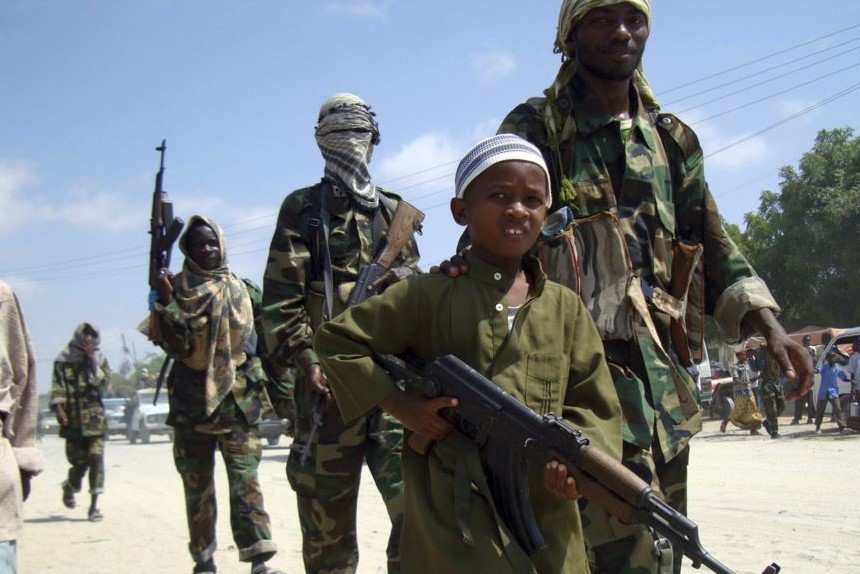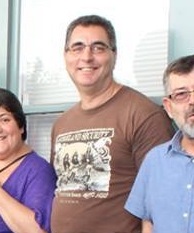AP photo
By
Rupen Savoulian
In the previous article, we looked at the use and simplistic portrayal of child soldiers in conflicts around the world. In this article, we examine the historical issues, and look at the contemporary problems of child soldiering.
In an incisive essay for Aeon magazine, Malcolm Harris wrote precisely on this issue of child soldiers. Entitled ‘Is the Child Soldier anything more than a tragic victim?’, Harris explores the shifting and simplistic definitions of child soldiers. Indeed, he points out that throughout the history of the West (at least, those societies that we historically link with the West), militarised youth were considered to be an acceptable part of any conflict. Harris cites examples of child soldiers that we hold up as virtuous heroes until today – Alexander the Great began his career of conquest as a 16-year old leader of Macedon; Clausewitz, the Prussian military author and general joined the army at 12.
Joan of Arc was a fighting adolescent, and is today revered in France for her courageous military role in the Lancastrian phase of the Hundred Years War. Joan of Arc was canonised as a Roman Catholic saint; Lord Nelson, the British general and hero of the Battle of Trafalgar, began his career as a child soldier in the Navy.
If we are to adapt a literal interpretation of the Old Testament, then we would have to conclude that King David, revered as an ancestor of the future messiah, was himself a boy of fifteen when he fought Goliath – today, he would be classified as a child soldier. You would be hard put to find one conflict throughout history where the use of militarised youth – at least adolescents – was not a normal and acceptable feature. Harris summarises the findings of Professor Mark Drumbl, who wrote a book in 2012 called Reimagining Child Soldiers in International Law and Policy. Drumbl examines the historical role of child soldiering, and looks at the fact that the presence of children fighting in a military capacity was regarded as a sign that their cause was just, positive and blessed by God.
Drumbl explains the findings of his research in this video presentation. He makes observations that Western audiences would find surprising – most of the world’s child soldiers are adolescents, usually between the ages of 15 and 17. The majority of the world’s child soldiers are not forcibly conscripted or abducted – about two-thirds of militarised youths volunteer to fight for one side or another. Volunteering can come about in various ways – familial ties to a group, social pressures to defend your community against hostile forces, signing up to join political movements to achieve specific political goals such as in conflicts in Latin America and today among the Syrian Kurds of Rojava.
Indeed, during the 2011 uprising in Libya, when anti-Gaddafi militias rose up in rebellion, the youth in that country – and Libyan exiles outside – joined in military activities to oust the Gaddafi regime. Salman Abedi, the Manchester suicide bomber, began his military activities as one of many British Libyans sent with the approval of the British authorities to join that conflict in 2011. Abedi would have been only 15 or 16 at the time – an officially sanctioned child soldier.
He fought, along with thousands of other youths, in a campaign officially supported by the imperialist states, such as Britain and France. The NATO bombing of Libya did materially assist, among others, the youthful anti-Gaddafi child soldiers fighting as part of a wider campaign against the regime. No qualms about child soldiering here.
The use of child soldiers was not always regarded as an act of criminality, immediately condemning the practitioners with international disgrace. It is interesting to note that during the Cold War, Hollywood made a film called Red Dawn (1984), an account of a fictional Soviet invasion of the United States. In that film, the heroic protagonists are a group of courageous American adolescents, who take up an underground guerrilla war against the foreign invaders – in other words, child soldiers.
The Wolverines, named after their school mascot, had no moral dilemmas or anxieties about taking up arms against a foreign occupying force. The writers and producers of that movie may not have realised it, but they did predict the future – but not in the way they intended.
In 2003, in the immediate aftermath of the American invasion of Iraq, the occupying US forces did face stubborn resistance by, among other groups, the Fedayeen Saddam, the paramilitary and youth wing of the former Ba’athist Iraqi regime. These child soldiers – formerly known as Saddam’s Lion Cubs – were the Iraqi equivalent of the Wolverines in the fictional story. These child soldiers, all grown-up today and facing the marginalisation of Sunni Iraqis from the current post-2003 sectarian political setup, are ironically lending their skills and expertise to the ISIS militia.
**********
If boy soldiering is portrayed as the province of the drug-induced demon-bandit, girl child soldiers are represented as vulnerable to the threats of sexual violence. There is great truth in this depiction – young girls are exploited for sexual purposes around the globe, and it is a serious problem. There are guerrilla groups and state-military forces who recruit on the basis of threatening sexual harm to young girls. For instance, the former guerrilla outfit and current political party in Mozambique, Renamo, did forcibly abduct and recruit child soldiers. An anti-communist movement, it was started and financed by the former white Rhodesian intelligence service, and became a proxy army for Rhodesia, and later apartheid South Africa.
We will also find that girls join guerrilla groups and become child soldiers precisely to escape sexual violence – usually the sexual assaults committed by state-militaries. Yvonne Keairns, a researcher at the Quaker UN office, found that girls from different conflicts – the Philippines, Colombia, Sri Lanka – volunteered to become soldiers for a variety of reasons – to find protection from an abusive military; to escape the socially conservative mores of the traditional family; to find a sense of purpose and belonging.
In 2003, she wrote a book on The Voices of Girl Child Soldiers. Keairns encourages the readers to listen to the girls, and understand their reasons for becoming soldiers. There are strict procedures and protocols to be followed for any interaction between boys and girls among the guerrilla groups – Keairns research is summarised by Harris in his article for Aeon magazine:
One Sri Lankan militant describes escaping her home on the eve of an unwanted marriage. The statements of the Filipina militants are especially striking: the girls report taking part in a culture of mutual criticism, where they had plenty of time to study, and the group listened to their voices. Training included a lecture on strict sexual harassment policies. ‘In the seminar, it was made clear that it was absolutely prohibited to take advantage of women,’ one interviewee said. ‘I felt very safe; I had no fear.’
And, contrary to Western ideas about the agency of female child soldiers, a majority of those interviewed had made a calculated choice to become militants.
In Harper’s magazine in 2005, Keairns relates the experience of a Colombian girl, once a child soldier and now participating in a reintegration programme. The young woman states that she was the victim of violent abuse by members of her family; she joined the a leftwing Colombian guerrilla group. She explained that:
Among the guerrillas, no man has the right to be disrespectful toward a woman, nor do you have the right to insult someone there. If you insult someone you get punished. Nobody hit me, nobody insulted me. I mean, after that the guerrillas were like my family. I settled in. I never got bored or fed up with the guerrillas, but I had a good time, because the commanders helped you a lot, and it’s very different when nobody is telling you off or hitting you all the time, and I really changed a lot. But then later, I don’t know, that changed, and I ran away from there.
She explained that among the guerrillas she received an education, learned new skills, was taught how to fight, found a sense of belonging and safety, and overcame her fears. As a guerrilla, she helped poor people, there was a culture of mutual criticism, and were advised to resolve their internal problems through dialogue and conciliation. She did have fears though:
I wasn’t afraid of dying but of being taken alive by the army. One of the girls was taken alive; she was about sixteen years old. They captured her and they all raped her, all the soldiers, more than a hundred, and then at the end when they were tired of that, they stuck their rifle barrels into her vagina and fired and then they poured sulfuric acid on her. They buried her, and then afterward we went there and dug her up, and we gave her military honors, and we bathed her, and then we looked at her, and then we dressed her, and then we took her to be buried in another cemetery. We were very angry, and so we went and fought the army for two days running.
The Marxist-feminist guerrillas of the Syrian Kurdish Women’s Protection Units (YPG) are the latest example of young girls and women taking up arms against a misogynist opponent – in their case, to fight the ISIS militants. They became a kind of cause celebre in the Western media; taking the battle to ISIS and fighting the good fight. Among their ranks there are under-18s, inducing the editors of one major magazine to announce that they do not condone the use of child soldiers.
Ironically, while ISIS is routinely (and rightly) denounced for their recruitment and use of child soldiers, the US-organised and led coalition of Iraqi militias fighting to retake Mosul has been recruiting, among others, under-18s to join their Popular Mobilisation Units, thus creating a new generation of child soldiers.
**********
In order to understand child soldiering, let us move beyond the sound-bite messages and simplistic stereotypes that abound in the major media. Understanding something is not an exercise in justification. This is not an endorsement of child-soldiering – all recruitment for under-18s should be banned in all countries and situations. However, let us abandon our hypocrisies surrounding the use of child soldiers; and let us fully understand why it is that adolescents volunteer to become child soldiers. Militarised youth are not always a criminalised entity – retributive sanctions against the practitioners, while warranted, must also be combined with restorative justice.
Rupen Savoulian
I am an activist, writer, socialist and IT professional. Born to Egyptian-Armenian parents in Sydney, Australia, my interests include social justice, anti-racism, economic equality and human rights.



No Comments Yet!
You can be first to comment this post!